HyperScale Edge node can be deployed with active backup or Link Aggregation Control Protocol (LACP) bonding mode.
With active backup, the interfaces are bonded for redundancy (or fault tolerance mode). Only one interface works at any moment and the other one will work when the first one fails.
When using LACP, each pair of ports should be configured as an active port-channel, and not configured to negotiate the aggregation protocol.
Note
When the deployment is complete, the password based root access is disabled and firewall and ransomware protection settings are enabled on the node automatically.
Before You Begin
Verify the requirements needed for setting up the Bonded Topology in your environment.
Tip
Keep the network names and IP addresses listed in the Network Requirements section of Bonded Topology handy before you start the configuration.
Procedure
-
Log on to the node using the system console as described in Setting up the installation media. (Do not use PuTTy / SSH to setup the nodes.)
-
Launch the network configuration interface using the following command:
The HyperScale Edge Installer page appears.# hssetup
-
Click Start.
The Network Configuration page appears.
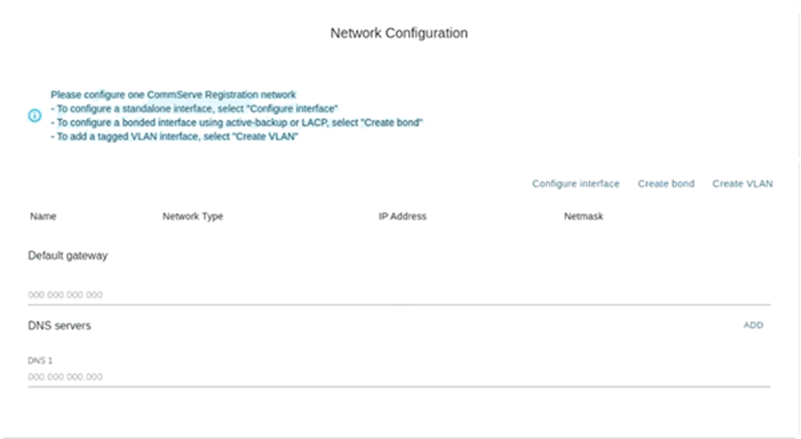
-
Create a data protection interface bond as follows:
-
Click Create bond.
The Create bond dialog box appears.
-
From the Interfaces list, select the data protection interfaces. (enpsf3 or enpsf5)
-
From Bonding mode list, select either active-backup (Mode 1) or LACP (Mode 4).
-
Click CREATE.
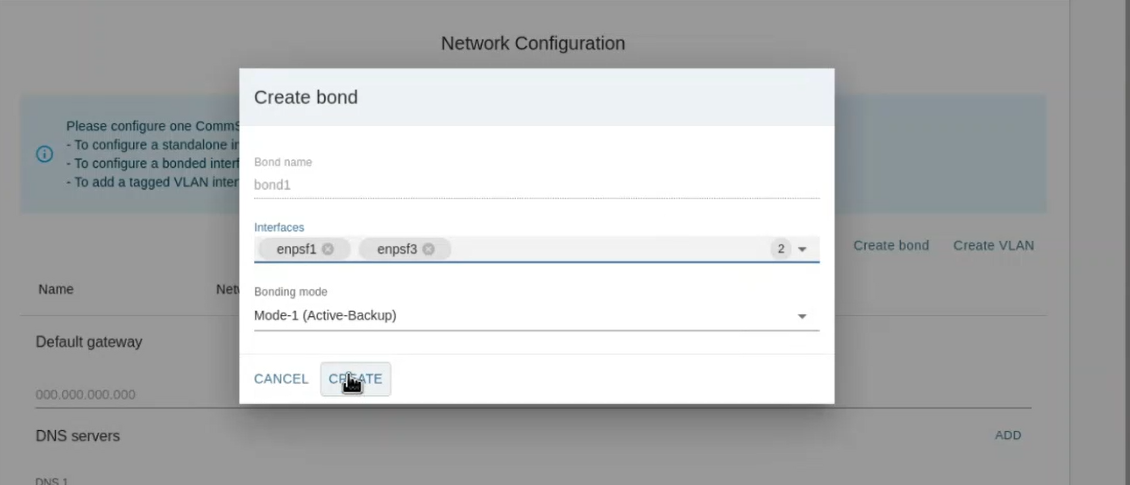
The bond1 interface appears in the Network Configuration page.
-
From the Network Type list, select CommServe Registration
-
Add the IP Address and Netmask in the respective boxes.
Once completed your screen should be similar to the one shown in the following image:

-
-
Configure the DNS server(s) as follows:
-
In the Default Gateway box, add the IP address associated with the default gateway.
-
In the DNS Servers box, add the IP address associated with the DNS Server.
Click the ADD button to add additional DNS servers. A maximum of 3 DNS servers can be added.
Note
Multiple DNS servers are recommended.
Once completed your screen should be similar to the one shown in the following image: (The number of DNS servers may vary depending on the number of servers available in your environment.)
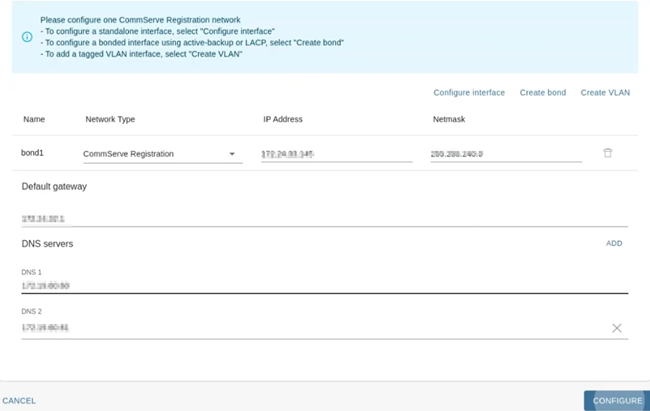
Note
Verify that the bonding mode is the same for both the data protection and storage pool bonds. Hover the cursor over the check box associated with the bond to view the bonding mode and other information associated with the interfaces.
-
Click CONFIGURE.
The software validates the network. (This may take a few minutes to complete.)
The Network Configuration Summary page appears.
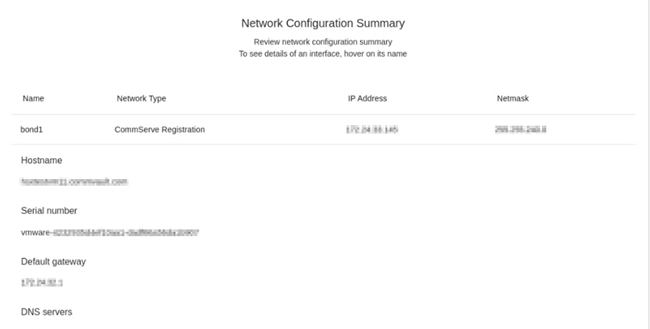
-
-
Verify the network configuration and then click CONTINUE.
The Node Details dialog box appears.
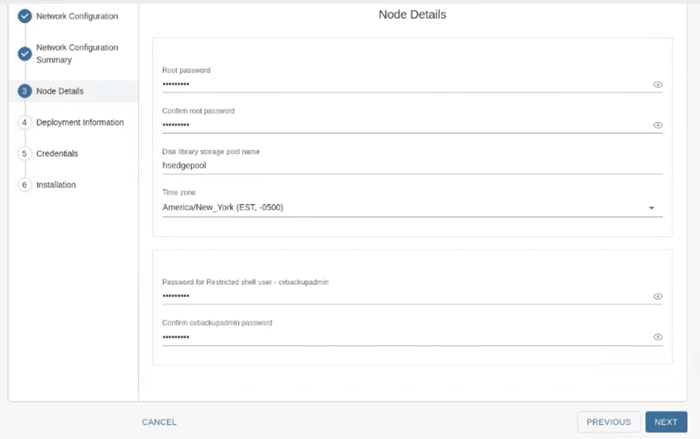
-
Add the following information:
-
In the Root password and Confirm password boxes, type a secure password for the nodes.
Tip
Hover the cursor over the Root password box to view the password requirements.
-
In the Disk library Storage pool name box, type a name for the storage pool associated with the cluster.
The storage pool name can include numbers and alphabets. Special characters cannot be used in the storage pool name.
Tip
Note down the storage pool name. This will be helpful to identify the storage pool in the Metallic console.
-
From the Time zone list, select the time zone in which the nodes are located.
-
In the Password for Restricted shell user - cvbackupadmin and Confirm cvbckupadmin password boxes, type a secure password for the cvbackupadmin user.
-
Click NEXT.
Note
The setup process configures the network for the node. This will take some time to complete.
The Deployment Information page appears.
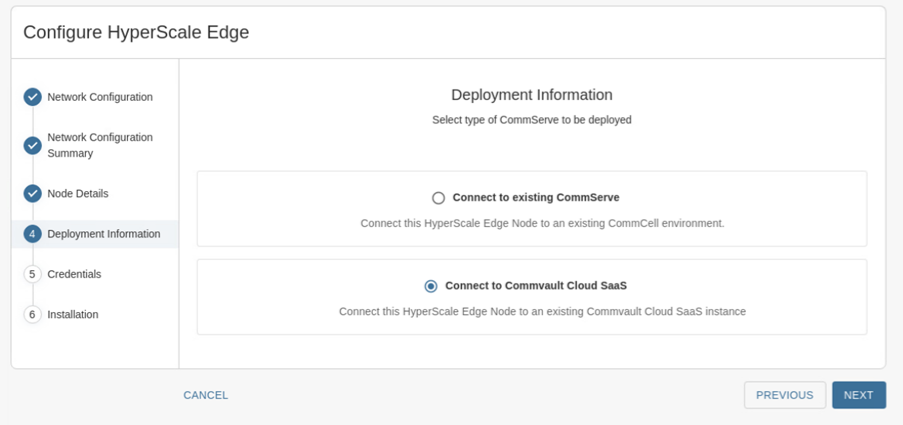
-
-
Click Connect to Commvault Cloud SaaS, and then click NEXT.
The Credentials page appears.
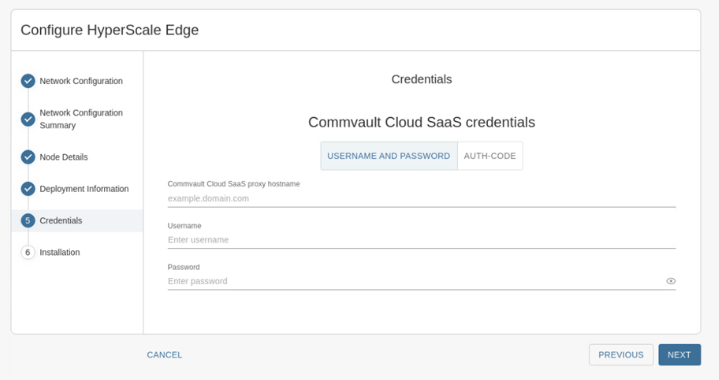
-
Choose one of the following options to connect to the CommServe:
-
To connect using the user credentials, in the UserName and Password tab, provide the following details:
-
In the Commvault Cloud SaaS proxy hostname box, enter the fully qualified host name of the existing Server Gateway that you are connecting to.
Note
TCP Ports 8400 & 443 must be open from the nodes to the Server Gateway for the registration to work.
-
In the Username and Password boxes, enter the credentials of the tenant admin user that must be used to access the Server Gateway and then click NEXT.
-
-
To connect using an authorization code, enter the following information.
Note
When you install using an authorization code, the installation process does not create the disk storage pool automatically. You must manually create the storage pool from the Command Center after the installation. For more information, see Creating a Disk Storage Pool.
-
Click the AUTH-CODE tab.

-
In the Commvault Cloud SaaS proxy hostname box, enter the fully qualified host name of the existing Server Gateway that you are connecting to.
Note
TCP Ports 8400 and 443 must be open from the nodes to the Server Gateway for the registration to work.
-
In the Auth-code box, enter the authorization code.
-
Click NEXT.
-
The software validates the information and will start the installation process. This process may take some time (approximately 45 minutes) to complete. You can monitor the progress using the progress bar.
Caution
Do not reboot or stop the installation during this process.
The completion message is displayed once the installation is completed.
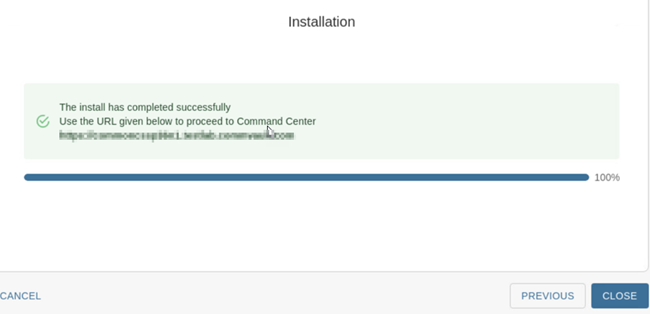
If the storage pool creation fails during the installation, you can manually create the disk storage pool from the Metallic console. For more information, see Creating a Disk Storage Pool.
-
-
Click CLOSE.
What to Do Next
Complete the additional configurations that may be required to customize your environment. For more information, see What to do Next.